Abstract
1. The cell walls of Corynebacterium tritici contain much carbohydrate and their mucopeptide contains diaminobutyric acid instead of lysine or diaminopimelic acid. They are resistant to lysozyme. 2. The residue after extraction with hot formamide contains only about 10% less carbohydrate but is attacked by lysozyme. Lysozyme also slowly attacks cell walls treated with fluorodinitrobenzene and more rapidly cell walls that have been N-acetylated. 3. All these processes block the free γ-amino groups of diaminobutyric acid present in the untreated cell wall. Hot formamide introduces formyl groups, as shown by its ability to make formylglycine and diformyl-lysine under the same conditions. 4. N-Formyl groups are also introduced into the cell walls of Micrococcus lysodeikticus by hot formamide, but this change increases only slightly their already great sensitivity to lysozyme. N-Acetylation also increases sensitivity to lysozyme.
Full text
PDF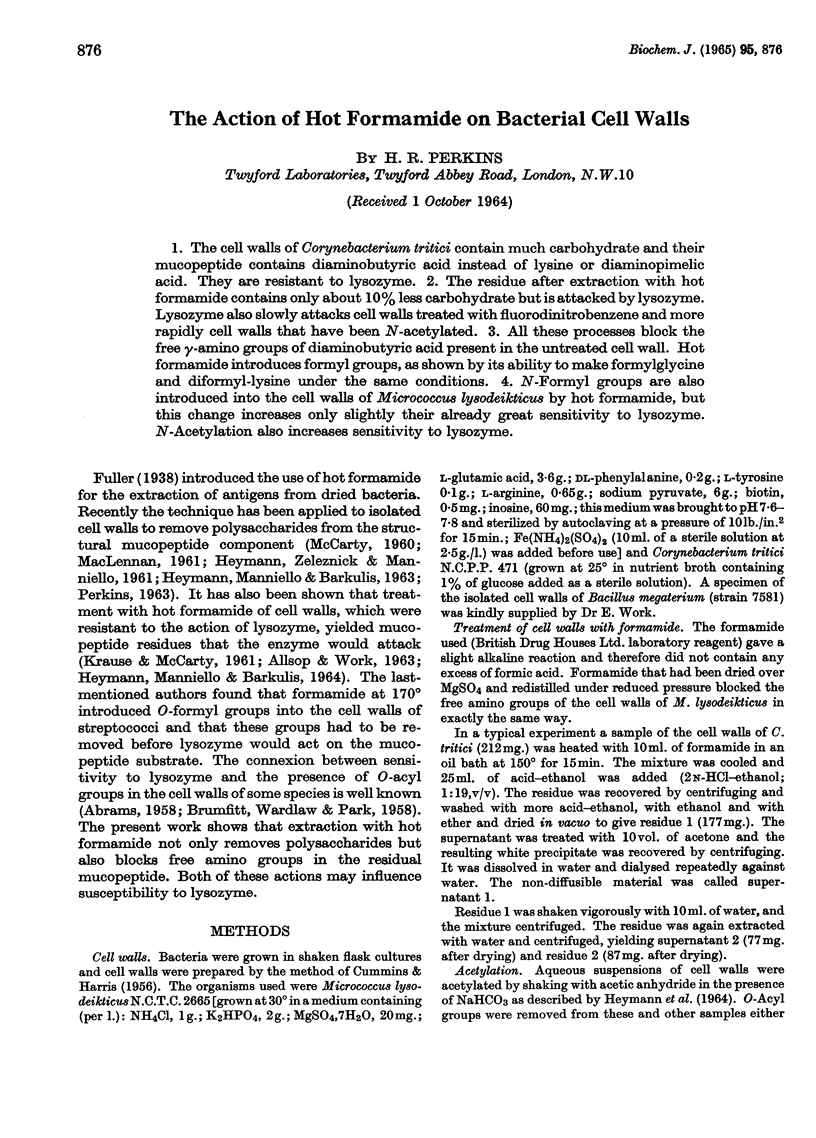

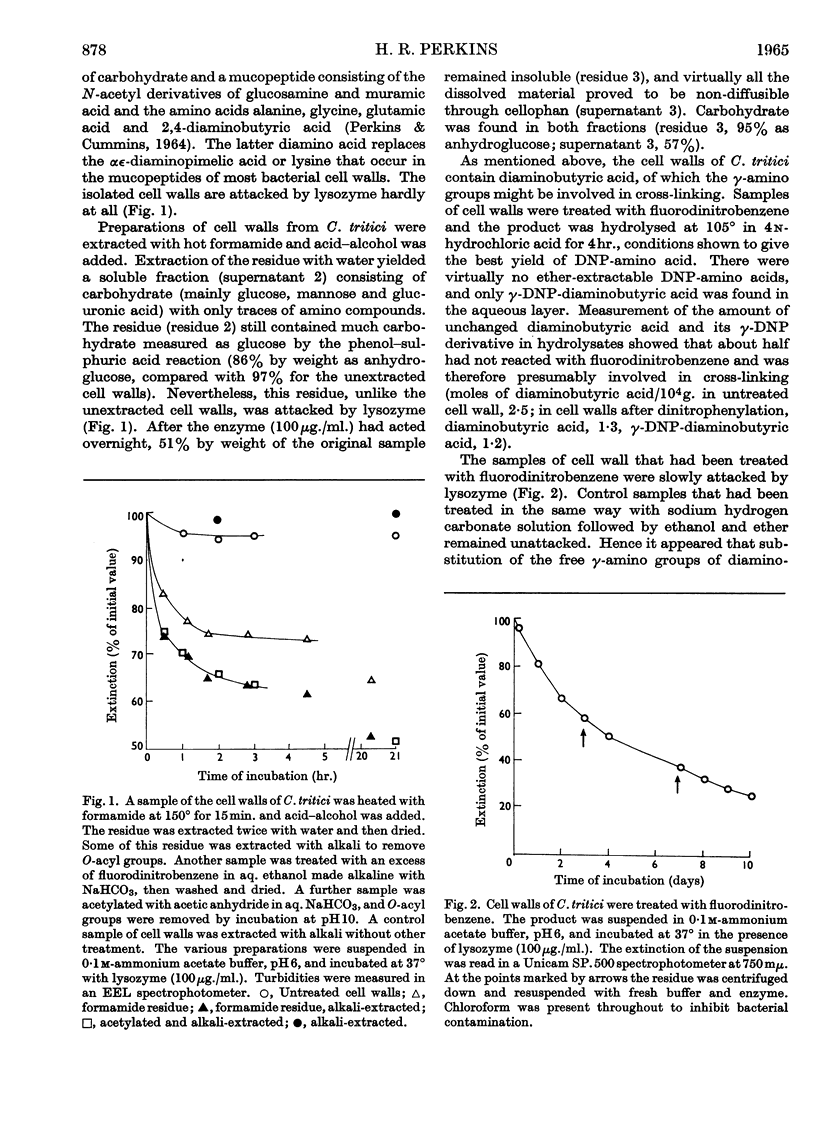
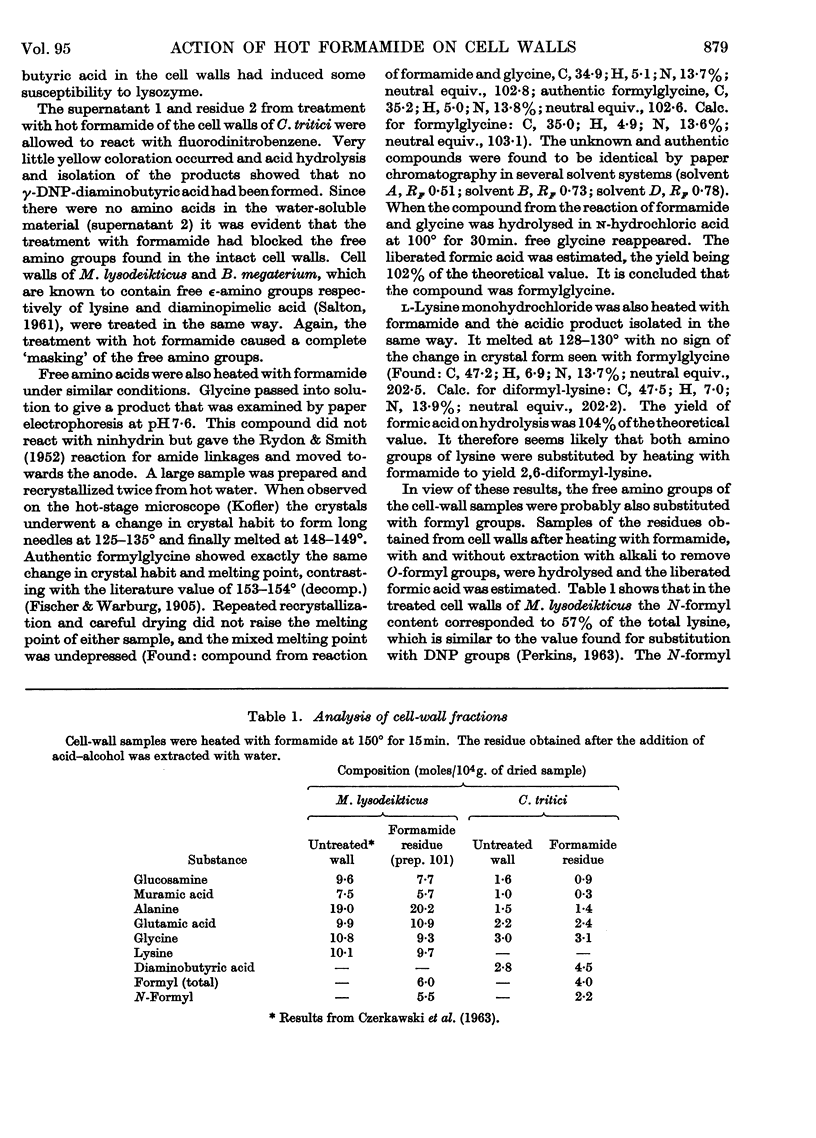
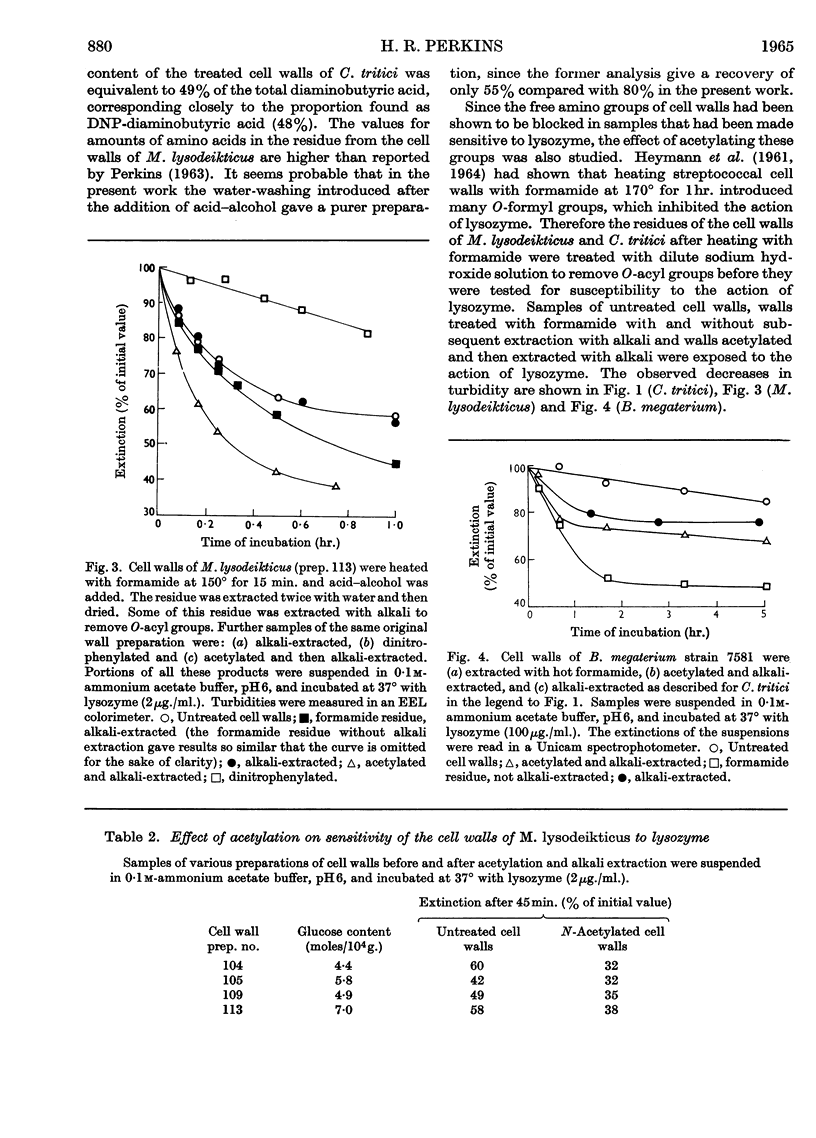
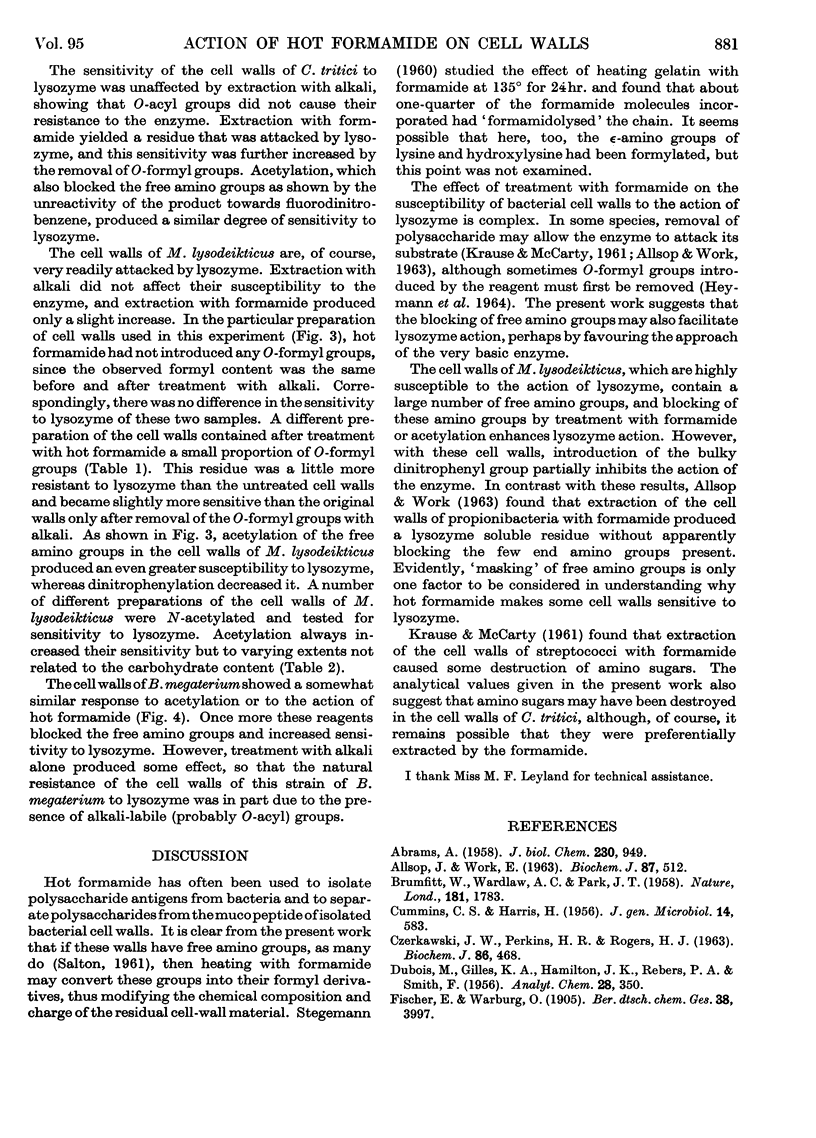
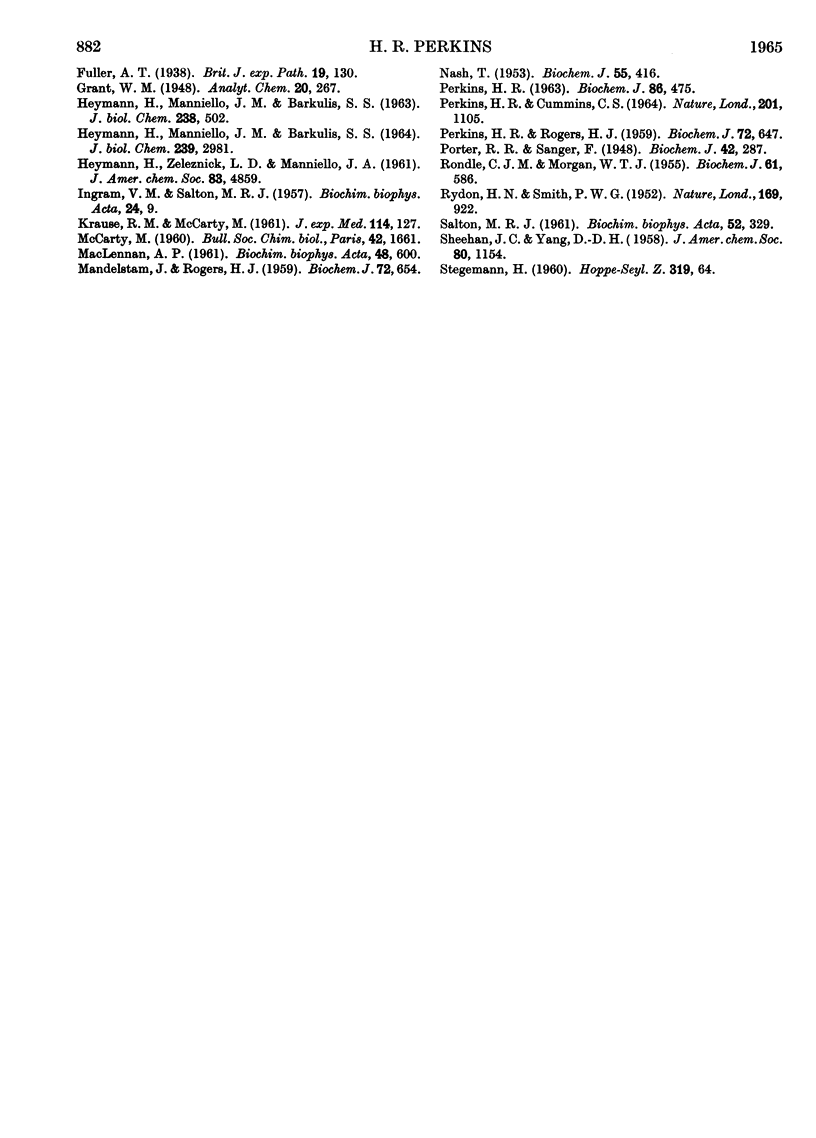
Selected References
These references are in PubMed. This may not be the complete list of references from this article.
- ABRAMS A. O-acetyl groups in the cell wall of Streptococcus faecalis. J Biol Chem. 1958 Feb;230(2):949–959. [PubMed] [Google Scholar]
- ALLSOP J WORK E. Cell walls of Propionibacterium species: fractionation and composition. Biochem J. 1963 Jun;87:512–519. doi: 10.1042/bj0870512. [DOI] [PMC free article] [PubMed] [Google Scholar]
- BREITENBACH J. W., DERKOSCH J., WESSELY F. Energetics of peptide formation. Nature. 1952 May 31;169(4309):922–922. doi: 10.1038/169922a0. [DOI] [PubMed] [Google Scholar]
- BRUMFITT W., WARDLAW A. C., PARK J. T. Development of lysozyme-resistance in Micrococcus lysodiekticus and its association with an increased O-acetyl content of the cell wall. Nature. 1958 Jun 28;181(4626):1783–1784. doi: 10.1038/1811783a0. [DOI] [PubMed] [Google Scholar]
- CUMMINS C. S., HARRIS H. The chemical composition of the cell wall in some gram-positive bacteria and its possible value as a taxonomic character. J Gen Microbiol. 1956 Jul;14(3):583–600. doi: 10.1099/00221287-14-3-583. [DOI] [PubMed] [Google Scholar]
- CZERKAWSKI J. W., PERKINS H. R., ROGERS H. J. A study of the composition and structure of the cell-wall mucopeptide of micrococcus lysodeikticus. Biochem J. 1963 Mar;86:468–474. doi: 10.1042/bj0860468. [DOI] [PMC free article] [PubMed] [Google Scholar]
- HEYMANN H., MANNIELLO J. M., BARKULIS S. S. STRUCTURE OF STREPTOCOCCAL CELL WALLS. 3. CHARACTERIZATION OF AN ALANINE-CONTAINING GLUCOSAMINYLMURAMIC ACID DERIVATIVE LIBERATED BY LYSOZYME FROM STREPTOCOCCAL GLYCOPEPTIDE. J Biol Chem. 1964 Sep;239:2981–2985. [PubMed] [Google Scholar]
- HEYMANN H., MANNIELLO J. M., BARKULIS S. S. Structure of streptococcal cell walls. I. Methylation study of C-polysaccharide. J Biol Chem. 1963 Feb;238:502–509. [PubMed] [Google Scholar]
- KRAUSE R. M., MCCARTY M. Studies on the chemical structure of the streptococcal cell wall. I. The identification of a mucopeptide in the cell walls of groups A and A-variant streptococci. J Exp Med. 1961 Jul 1;114:127–140. doi: 10.1084/jem.114.1.127. [DOI] [PMC free article] [PubMed] [Google Scholar]
- MACLENNAN A. P. Composition of the cell wall of Actinomyces bovis: the isolation of 6-deoxy-L-talose. Biochim Biophys Acta. 1961 Apr 15;48:600–601. doi: 10.1016/0006-3002(61)90062-2. [DOI] [PubMed] [Google Scholar]
- MANDELSTAM J., ROGERS H. J. The incorporation of amino acids into the cell-wall mucopeptide of staphylococci and the effect of antibiotics on the process. Biochem J. 1959 Aug;72:654–662. doi: 10.1042/bj0720654. [DOI] [PMC free article] [PubMed] [Google Scholar]
- MCCARTY M. Chemical basis for serological specificity of cell wall carbohydrates of group A streptococci. Bull Soc Chim Biol (Paris) 1960;42:1661–1667. [PubMed] [Google Scholar]
- NASH T. The colorimetric estimation of formaldehyde by means of the Hantzsch reaction. Biochem J. 1953 Oct;55(3):416–421. doi: 10.1042/bj0550416. [DOI] [PMC free article] [PubMed] [Google Scholar]
- PERKINS H. R. A polymer containing glucose and aminohexuronic acid isolated from the cell walls of micrococcus lysodeikticus. Biochem J. 1963 Mar;86:475–483. doi: 10.1042/bj0860475. [DOI] [PMC free article] [PubMed] [Google Scholar]
- PERKINS H. R., CUMMINS C. S. CHEMICAL STRUCTURE OF BACTERIAL CELL WALLS. ORNITHINE AND 2,4-DIAMINOBUTYRIC ACID AS COMPONENTS OF THE CELL WALLS OF PLANT PATHOGENIC CORYNEBACTERIA. Nature. 1964 Mar 14;201:1105–1107. doi: 10.1038/2011105a0. [DOI] [PubMed] [Google Scholar]
- PERKINS H. R., ROGERS H. J. The products of the partial acid hydrolysis of the mucopeptide from cell walls of Micrococcus lysodeikticus. Biochem J. 1959 Aug;72:647–654. doi: 10.1042/bj0720647. [DOI] [PMC free article] [PubMed] [Google Scholar]
- Porter R. R., Sanger F. The free amino groups of haemoglobins. Biochem J. 1948;42(2):287–294. doi: 10.1042/bj0420287. [DOI] [PMC free article] [PubMed] [Google Scholar]
- RONDLE C. J., MORGAN W. T. The determination of glucosamine and galactosamine. Biochem J. 1955 Dec;61(4):586–589. doi: 10.1042/bj0610586. [DOI] [PMC free article] [PubMed] [Google Scholar]
- SALTON M. R. Studies of the bacterial cell wall. VIII. Reaction of walls with hydrazine and with fluorodinitrobenzene. Biochim Biophys Acta. 1961 Sep 16;52:329–342. doi: 10.1016/0006-3002(61)90682-5. [DOI] [PubMed] [Google Scholar]


